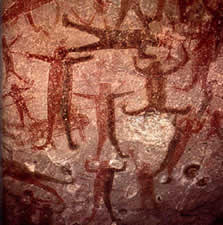Mexican Cave Art

Driving to Mexico can be like traveling back in time if you go to the right places. Unlike the US, where widespread development has made it hard to find traces of native civilization, Mexico has many archaeological sites, some of which feature the cave paintings, or pinturas rupestres, dating back hundreds or thousands of years to the Maya and Olmec people.
But before you leave the present, make your immediate future a lot easier
by purchasing Mexican
auto insurance. Mexican
law requires every vehicle entering the country to be covered by a Mexican
insurance policy. The easiest way to purchase your Mexican insurance
policy is by taking care of it online before you leave home.
Get a quote
and purchase a policy.
Who wrote on the walls?
In cultures without a written language, people told their stories with pictures. The human and animal figures in Mexico's cave paintings, along with more abstract symbols, might tell the story of a hunt or battle. They could represent a family's lineage, a tribe's head count, a legend or a spiritual belief. The artists painted on rocks with mixtures of plant or animal matter combined with mineral powders. The caves were certainly their shelters and possibly their meeting or worship places.
Archeologists divide Pre-Columbian Mexico into the Archaic, Middle Preclassic and Late Preclassic Eras. These civilizations included the Olmec, Izapa, Teotihuacan, Maya, Zapotec, Mixtec, Huastec, Tarascan, Toltec and Aztec people. Aztec cave art may be difficult to find, partly because they preferred parchment to rock, and partly because the Spanish conquistadores and missionaries worked aggressively to erase Aztec civilization.
Where to find cave art
The Baja Peninsula has some of the best cave paintings in all of Mexico. Little is known about the people who created the paintings, but the artwork is both impressive in quality and in size. Some locations such as Cueva Pendita has a 500 foot wall of well preserved cave paintings. San Borjitas, near Mulege, is another excellent cave art site.
Some of the better-known sites include:
- San Borjitas (near Mulege) - Baja California
- Balank'anche Cave - Yucatan
- Loltun Cave - Yucatan
- Guila Naquiz Cave - Oaxaca
- Juxtlahuaca Cave - Guerrero
- Oxtotitlan Cave - Guerrero
- Nogales Cave - Tamaulipas
- La Perra Cave - Tamaulipas
Mexico is large country with diverse geography, which is reflected in the size and location of these caves. The San Borjitas paintings can be found in shallow rock shelters on a mountainside, while the Juxtlahuaca site is distributed over five kilometers of underground caverns.
What to expect
Tourism is a big factor at many of Mexico's historical sites, and US travelers visiting the more spectacular caves will encounter visiting hours, entry fees, designated guides, and souvenirs for sale. To view cave art in less traveled regions, consider hiring a local guide and be respectful of Mexico's archeological treasures even when there are no signs or walkways. Be sure to wear comfortable, sturdy shoes and carry your own drinking water. Bring a sweater, too, because underground temperatures can be surprisingly cool even on the hottest day. Good thing you've got your vehicle with you since that makes it easy to keep all those items you take in your car for cool weather with you. Happy spelunking!





